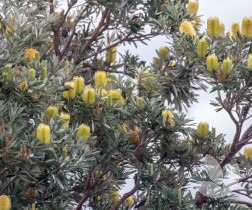Our office will be closed from midday on Wednesday 24th December 2025, re-opening Monday 5th January 2026. Cut-off for delivery is noon on Monday 22nd December 2025. The team at Speciality Trees wish you and your loved ones a happy and safe festive season.

Knowing how close you are to the coastline is important. For planting right on the beach, deemed ‘Frontline coastal’, trees and plants need to have an in-built propensity to tolerate salt-laden winds. This vegetation often has fine foliage, and trees are dense in form to control erosion and provide an effective wind barrier.
Think of the low-laying scrub and tea tree you see at the beach! The vegetation that exists there hugs the ground as much as possible so that the harsh coastal, salty winds can scoot over the top. Within these microclimates, you will find tough growing conditions too where salt residue combines with sandy soil making establishment very difficult. But trees and plants will grow there.
In high winds, trees with narrow foliage such as Allocasuarina verticillata is considered an appropriate selection as their thin leaves offer less friction and resistance to harsh wind. This is a good coping mechanism in a frontline coastal position. In another example, the broader leafed Banksia integrifolia and the narrower growing Banksia integrifolia ‘Sentinel’ also copes well due to a waxy coating on its foliage. It is this hard, rubbery attribute that allows them to withstand the absorption of salt. Consider too, succulents such as Kalanchoe that have fine hairs on their leaves that act to slow the velocity of the wind, thereby minimising water loss.
When it comes to coastal it is best to talk to horticulturists who can draw on their experience and training to know what works best. From a tree perspective Allocasuarina verticillata, Banksia integrifolia and Leptospermum laevigatum are true frontline warriors and sit at the top of our list.
However, walk back 500m or a couple of streets and there exists a broader list of trees for planting in coastal suburbs. These include: Laurus nobilis (Bay Tree), Acacia melanoxylon, Agonis, Corymbia ficifolia - but not the grafted form, Olives, Ulmus parvifolia (Chinese Elm), Fraxinus griffithii, Callistemon, Prunus lusitanica (Portuguese Laurel), Juniperus chinensis ‘Spartan’ and Cupressus sempervirens ‘Glauca’ (Italian Pencil Pine). Another, Elaeocarpus reticulatus will tolerate sandy coastal soils but not salt-laden winds.
All of these have the potential of being burnt by salty winds, so it is a good idea to plant them out with other vegetation for combined protection. And make sure to improve the soil where possible with the addition of quality organic compost, additional imported screened soil and wetting agent. Don’t forget to mulch to a depth of 80mm. There is a lot of aquaphobic or water-repellent coastal soils around Melbourne so soil improvement is a must to ensure tree establishment in this challenging environment.
For a broader list than what has been provided here, please click here.
For more information, please contact us.
Receive all the latest news, product information, collections, projects, tips and special offers straight to your inbox each month or so.
Receive all the latest news, product information, collections, projects, tips and special offers straight to your inbox each month or so.
Find a Tree
With more than 400 trees in our library we can help you find the perfect tree for your next project.
Ask a question
We're here to help if you need any advice on selecting the perfect tree for your next project.
Newsletter
Receive all the latest news, product information, collections, projects, tips and special offers straight to your inbox each month or so.
Treefinder can help you identify the perfect tree for your next project!
With over 400 tree varieties for review, the Treefinder app enables you to conveniently browse and compile a list of trees suitable for a number of common landscaping uses - from attracting birds to creating a formal screen or hedge. By selecting desired size, foliage, and a few categories, Treefinder opens up a world of possibilities.
Once you've found the perfect tree you can click through to our website for more information, availability and a quote.

We are specialists in the environmentally sustainable production of premium quality advanced landscaping trees and screens.
For more than 49 years Speciality Trees has been a leader in the production and supply of advanced environmentally sustainable, containerised landscape trees for local government, the landscaping industry and retailers.
Learn more















